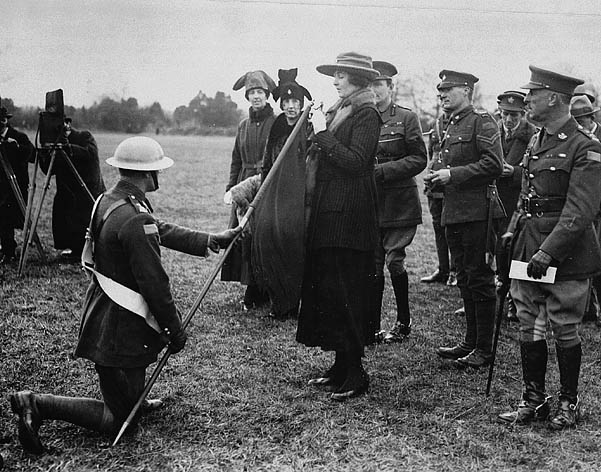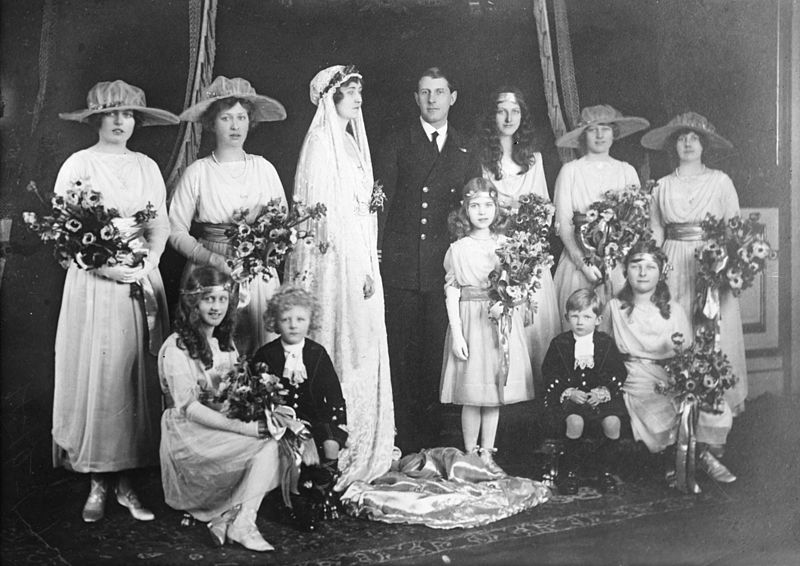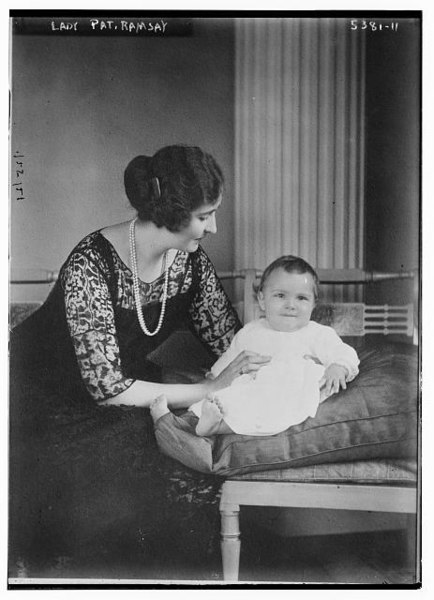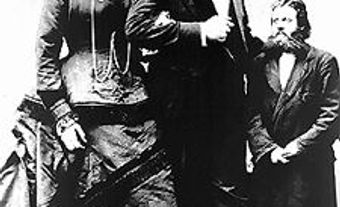
Early Life
Patricia was born on 17 March 1886 at Buckingham Palace, the youngest of three children to Prince Arthur, Duke of Connaught, and Princess Louise Margaret of Prussia, Duchess of Connaught. She was named Victoria for her paternal grandmother, Queen Victoria, and Patricia because she was born on St. Patrick’s Day. As the third son of Queen Victoria, the Duke of Connaught held a series of military and diplomatic postings across the British Empire and dominions. Patricia travelled with her parents from a young age, residing with them in India from 1887 to 1890, where she “began to speak a mixture of English, German and Hindustani,” undertaking an extended tour of Mediterranean Europe and North Africa in 1905, and attending the opening of the first Union parliament of South Africa in 1910.
A Mind of Her Own
When Patricia came of age, there was widespread speculation in the media that she would marry into one of Europe’s reigning families. King Alfonso XIII of Spain, Grand Duke Michael of Russia and the future King Manuel II of Portugal were among her suitors. Patricia, however, rejected any attempts to arrange a dynastic marriage.
Unlike her grandmother, Queen Victoria, who disapproved of the campaign for women’s suffrage, Patricia was more supportive of increased political rights for women — as was her aunt, Princess Louise. In 1913, Patricia appointed a prominent suffragist as a lady-in-waiting—a decision that the media interpreted as tacit support for women’s suffrage. Queen Mary, consort of her cousin King George V, strongly disapproved. The Toronto World reported on 26 September 1913 that the king, queen and princess had all been invited to the Spencer estate at Althorp, but the “Queen refused to meet [the suffragist] Miss Glenteil, and the princess would not go to Althorp without her,” with the result that Patricia accepted a different social invitation.
Canada
In 1911, the Duke of Connaught was appointed governor general of Canada. Patricia travelled with her parents to Canada and arrived in Québec City in October. Due to her mother’s ill health, Patricia often acted as her father’s hostess and accompanied him on official engagements and tours. “Princess Pat” became a popular public figure in Canada in her own right. In May 1912, Patricia travelled with her father to Winnipeg and the Maritimes. In the fall of 1912, Patricia and her parents toured Northern Ontario, Saskatchewan, Alberta and British Columbia and attended the first Calgary Stampede.
In honour of Patricia’s visit to Victoria in 1912, Union Bay was renamed Patricia Bay. The same year, the province of Ontario expanded north of the Albany River and named the new region the “District of Patricia.” (In 1937, the Patricia Act added the District of Patricia to the Kenora District and the region became known as the “Patricia Portion.”)
A popular figure in both Canada and America, Patricia was known for her athleticism. As one American newspaper reported at the time of her marriage in 1919, “[Patricia] is fond of outdoor sports and, during her tour of Canada with her father, the governor general, she rode her spirited horse over the mountains at Banff Springs, Alberta, beat her father at golf on the local golf links and gave an exhibition of expert swimming in the big swimming pool of the hotel.” She also embraced winter sports and hosted skating parties at Rideau Hall in Ottawa.

Art
Patricia was an accomplished artist who created more than 600 works in oils, watercolours, pen and ink and gouache over the course of her lifetime. During her time in Canada, she contributed her work to exhibitions, raising the profile of Canadian artistic associations. The Montreal Gazette reported that the Art Association of Montreal’s 1912 Spring Exhibition was a “social event,” with “added interest by reason of six canvases from the brush of HRH Princess Patricia of Connaught,” including “two snow scenes and a view from Government House, Ottawa.” Patricia was inspired by Canadian landscapes, painting in her studio at Rideau Hall and sketching during royal tours in such diverse settings as Lake Louise and Alert Bay on the Pacific Coast. Most of her paintings remained within her family, but there are examples of her art in Canadian collections, including her 1916 painting of “Ice breaking up in Spring on the Ottawa River, below the Rideau Falls” in the Art Gallery of Ontario.
First World War
Princess Patricia gave her name to Princess Patricia’s Canadian Light Infantry (PPCLI) in 1914. The regiment was sponsored by Montreal businessman Andrew Hamilton Gault and was the last privately funded regiment in the British Empire and dominions. The regimental commander, Lieutenant-Colonel Francis D. Farquhar, asked the Duke of Connaught for permission to name the regiment after Patricia. The princess took a close interest in her regiment, designing and creating the regimental colours or “Ric-A-Dam-Doo” (thought to be a Gaelic phrase for “cloth of our mother),” as the crimson flag with its royal blue centre and gold initials, V.P. (for Victoria Patricia), became known. At the presentation of the colours to her regiment, Patricia stated, “I have great pleasure in presenting you with these colours, which I have worked myself. I hope they will be associated with what I believe will be a distinguished corps. I shall follow the fortunes of you all with the deepest interest, and I heartily wish every man good luck and a safe return.” Patricia became honorary colonel-in-chief of the regiment in 1918.
Patricia’s creation of the regimental colours inspired a popular Canadian camp song that includes the lyrics, “A rick-a-bamboo/Now what is that?/Its something made/By the Princess Pat.”
Following her return to Britain in 1916 at the end of her father’s term as governor general, Patricia continued to take an interest in the Canadian military, volunteering at the Maple Leaf Club for Canadian soldiers in London and the Canadian military hospital in Orpington. Patricia also volunteered for the Red Cross in Canada and Britain during the First World War and founded Princess Patricia’s Red Cross Convalescent Hospital. The benefit concerts that she organized for the Red Cross brought together Canadian and international musical talent. In 1915, Australian soprano Nellie Melba and Canadian soprano Pauline Donalda performed at wartime benefit concerts at Rideau Hall.
In 1917, Patricia appeared on the Canadian $1 bill, which remained in circulation until 1923.

Marriage and Later Life
On 27 February 1919, at the age of 32, Patricia married the Honourable Alexander Ramsay (later Rear Admiral Sir Alexander Ramsay) in Westminster Abbey in London. Patricia was the first member of the royal family to marry at Westminster Abbey since King Richard II in 1382. The wedding set a precedent for royal weddings in the Abbey, including the future Queen Elizabeth II and Prince Philip, who married there in 1947. After the wedding, Patricia chose to be styled Lady Patricia Ramsay but continued to receive the precedence accorded to princesses at royal events.

Ramsay had served as naval aide-de-camp to the Duke of Connaught in Canada and proposed to Patricia at the fishing lodge of Canadian businessman J.K.L. Ross at St. Ann’s Bay in Nova Scotia. Their wedding attracted widespread public interest in Canada, and she received gifts from prominent Canadians. Members of the PPCLI attended the wedding, and the regimental march was among the music. The couple’s only child, Alexander (later Captain Alexander Ramsay of Mar), was born on 21 December 1919.

Patricia remained a prolific artist, joining the New English Art Club and becoming an honorary member of the Royal Institute of Painters in Water Colours. In 1942, she inherited a house, Ribsden Holt, in Windlesham from her aunt, Princess Louise, a fellow artist and former viceregal consort of Canada. She lived there until the end of her life. She spoke warmly of her time in Canada, describing Rideau Hall as “that much-loved house in those distant but ever-remembered days.”
1964 Visit to Canada
In September 1964, Patricia made an official visit to Edmonton to celebrate the 50th anniversary of the PPCLI, reviewing the regiment. She issued a statement in honour of the occasion:
It would be difficult to express in any way…the intense pride and affection I have always felt for my famous and magnificent Regiment. The gallantry, bravery and devotion to duty which the Regiment has shown unflinchingly ever since it came into being is beyond any powers of mine to praise. I can only render homage and this I do with all my heart. Believe me, I am indeed honoured that my name should be borne by such troops as Princess Patricia’s Canadian Light Infantry have shown themselves to be.
A new neighbourhood incorporated into Edmonton in 1964 was named Patricia Heights.
Death
Patricia died in 1974. She was succeeded as colonel-in-chief of the PPCLI by her goddaughter, Lady Patricia Brabourne Knatchbull, Countess Mountbatten of Burma (1924–2017). The Countess, a first cousin of Prince Philip, Duke of Edinburgh, served in the post until 2007, when she was succeeded by Adrienne Clarkson.

 Share on Facebook
Share on Facebook Share on X
Share on X Share by Email
Share by Email Share on Google Classroom
Share on Google Classroom
